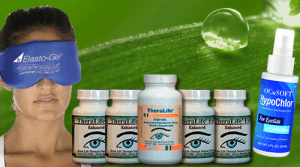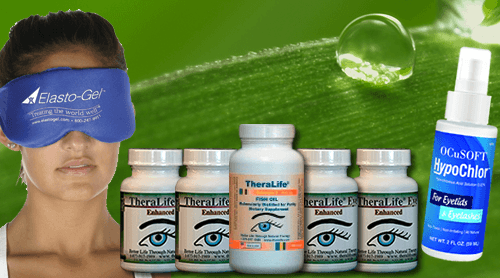Theralife.com offers a comprehensive range of products designed to benefit individuals with Sjögren’s syndrome and related conditions. Their offerings focus on alleviating symptoms such as dry eyes, blepharitis, and uveitis, providing targeted relief through natural and holistic approaches. Genetic insights into Sjögren’s syndrome, such as HLA gene associations and epigenetic mechanisms, underscore the importance of personalized treatment options, which Theralife aims to address with their tailored solutions.
Specifically, Theralife’s products are formulated to enhance eye health by addressing underlying inflammation and promoting natural tear production. This approach not only helps in managing symptoms but also supports overall eye wellness, which is crucial for individuals dealing with the chronic nature of Sjögren’s syndrome. The website provides valuable resources, including dietary recommendations and lifestyle tips, to complement their product offerings, ensuring a comprehensive support system for their customers.
All Natural Treatment For Sjogren’s Dry Eyes- TheraLife
Add To Cart
Key Takeaways
- Specific HLA alleles, particularly *DRB1*03:01 and *DQA1*05:01, are strongly associated with Sjögren’s syndrome susceptibility.
- Genetic risk variants for Sjögren’s syndrome vary by ethnicity and serological status.
- The X chromosome influences Sjögren’s syndrome risk due to immune-related genes escaping X inactivation.
- Familial aggregation indicates significant heritability, with high sibling, parental, and offspring risks.
- Epigenetic mechanisms, such as DNA demethylation and histone modifications, impact gene expression in Sjögren’s syndrome.
HLA Gene Associations
When examining the genetic factors of primary Sjögren’s syndrome (pSS), the strongest genetic signals are found within the HLA genes. HLA allele variability plays an essential role, with risk variants differing by ethnicity and serological status. Remarkably, HLA class associations highlight significant linkages with class II alleles such as *DRB1*03:01, *DQA1*05:01, and *DQB1*02:01. These alleles are consistently associated with pSS across multiple ethnic groups and are linked to the presence of autoantibodies like anti-Ro/SSA and anti-La/SSB. Genome-wide association studies reinforce these findings, revealing multiple HLA loci with substantial associations. Interestingly, the strongest genetic associations in pSS are found within the major histocompatibility complex (MHC). The prevalence of Sjögren’s syndrome is estimated at 0.1% to 4.8% in the general population, underscoring the need for continued research into its genetic underpinnings. Understanding these HLA gene associations provides insights into the pathogenesis of pSS and underscores the importance of tailored approaches based on genetic profiles.
Role of X Chromosome
You’re examining the significant role the X chromosome plays in Sjögren’s syndrome, especially considering the gender disparity where women are 10 to 20 times more susceptible than men. The high density of immune-related genes on the X chromosome, combined with variations such as aneuploidy, influences this risk, as evidenced by increased susceptibility in individuals with Klinefelter syndrome and reduced risk in Turner syndrome. Genetic risk factors contribute approximately 30% to the overall risk of developing Sjögren’s syndrome. An autoimmune diet, focusing on anti-inflammatory foods, can help manage symptoms by reducing gut inflammation. Investigating these genetic and epigenetic factors can provide insights into the mechanisms driving immune dysregulation in Sjögren’s syndrome.
Gender Disparity Impact
Understanding the gender disparity in Sjögren’s syndrome necessitates examining the role of the X chromosome, which is essential due to its concentration of immune-related genes. The female predilection for this condition is influenced by gender roles in genetics. Women, with two X chromosomes, exhibit a higher autoimmune prevalence partly because of gene dosage effects and X chromosome inactivation (XCI) inefficiencies. Approximately 20% of X-linked genes escape XCI, potentially amplifying immune response genes like TLR7, TLR8, and CD40LG. These genes are vital for immune regulation and tolerance. Studies show that altered X chromosome expression significantly impacts autoimmune disease susceptibility, highlighting the genetic factors at play in Sjögren’s syndrome. This heightened genetic expression can disrupt immune homeostasis, contributing to increased susceptibility. The coexistence of Sjogren’s syndrome with conditions like lupus underscores the complexity of genetic involvement in autoimmune diseases. The interplay of these genetic dynamics underscores the significant impact of the X chromosome on gender disparity in Sjögren’s syndrome.
Aneuploidy and Risk
Examining the role of aneuploidy in Sjögren’s syndrome reveals a significant link between extra X chromosomes and increased disease risk. Individuals with an extra X chromosome, such as those with Klinefelter syndrome (47, XXY) and trisomy X (47, XXX), demonstrate heightened susceptibility to primary Sjögren’s syndrome (pSS). Males with Klinefelter syndrome have a 38-fold increased incidence, while females with trisomy X show a 2.9-fold higher risk. These findings underscore the genetic predisposition associated with X chromosome-linked genes in pSS pathogenesis. Additionally, the female to male ratio is 9:1, indicating a higher prevalence in women. Sjögren’s syndrome often coexists with other autoimmune diseases, highlighting the complex interplay of genetic and environmental factors in its manifestation. The presence of additional X chromosomes potentially disrupts immune homeostasis, as these chromosomes harbor numerous immune-related genes. Consequently, the genetic architecture of the X chromosome substantially contributes to the risk profile for autoimmune conditions like pSS.
Immune Gene Density
The X chromosome is densely populated with immune response genes, playing a vital role in the pathogenesis of autoimmune diseases like primary Sjögren’s syndrome (pSS). Genes such as *TLR7*, *TLR8*, *BTK*, and *CD40LG* are integral in both innate and adaptive immunity. High gene dosage due to altered X chromosome inactivation (XCI) can lead to immune dysregulation. Females, with two X chromosomes, may exhibit increased susceptibility to autoimmune conditions due to XCI escape, resulting in overexpression of genes like *CXorf21*. This gene acts as a cytosolic adapter for TLR7, promoting IFNα production. Symptoms of Sjögren’s syndrome often include dry eyes and mouth, fatigue, and joint pain, complicating the diagnosis of this condition. In pSS, differential expression and methylation of X-linked genes highlight their significant contribution to disease mechanisms, underscoring the X chromosome’s essential role in immune responses. Interestingly, specific haplotypes involving the major histocompatibility complex (MHC) class II gene region are also linked to Sjögren’s syndrome, varying across different ethnic groups.
Epigenetic Influences
You’re likely aware that epigenetic modifications, such as DNA methylation and histone modifications, play a vital role in the dynamic modulation of gene expression in Sjögren’s syndrome. These modifications, influenced by environmental factors like viral infections, contribute to the complex pathogenesis of the disease by altering immune responses. Understanding these interactions provides essential insights into how epigenetic and environmental factors synergistically drive disease progression in genetically predisposed individuals. Genome-wide association studies (GWAS) have linked specific genetic variations, including human leukocyte antigen (HLA) allele subtypes, to Sjögren’s syndrome susceptibility. Notably, cevimeline is used to manage the symptoms of Sjögren’s syndrome by stimulating salivary gland secretion, which helps alleviate one of the condition’s primary symptoms, dry mouth.
Dynamic Gene Expression Modulation
While understanding Sjögren’s Syndrome (SjS), it’s crucial to focus on the intricate role of epigenetic influences in dynamic gene expression modulation.
DNA methylation greatly impacts dynamic regulation, altering gene expression in immune cells and salivary gland epithelial cells. The demethylation of genes such as RUNX1, LTA, and MxA is pivotal in SjS pathogenesis.
Concurrently, histone modifications modulate transcriptional availability, contributing to autoimmune responses. They act as a dynamic link between the genome and phenotypic manifestations.
In addition, non-coding RNAs play a critical role by affecting gene expression and modifying transcriptional availability, thereby influencing autoimmune pathways.
The chronic systemic autoimmunity seen in SjS shares similarities with rheumatoid arthritis, which also has significant ocular manifestations due to autoimmune mechanisms.
Collectively, these epigenetic mechanisms intricately regulate gene expression, underscoring their importance in the pathophysiology of Sjögren’s Syndrome.
Environmental Epigenetic Interactions
Building on the concept of dynamic gene expression modulation, environmental factors greatly influence epigenetic modifications in Sjögren’s Syndrome (SjS).
Environmental triggers like viral infections, particularly Epstein-Barr virus, and bacterial infections can initiate immune responses, contributing to SjS in genetically predisposed individuals. These triggers lead to epigenetic modifications, such as DNA methylation, histone modifications, and non-coding RNA involvement, essential to SjS pathogenesis.
DNA methylation specifically alters gene expression, driving immune cell changes and abnormal activations. Histone modifications also play a role, although less understood. Non-coding RNAs regulate genes implicated in SjS.
In addition to Sjögren’s Syndrome, Rheumatoid Arthritis is another autoimmune disorder that can present with dry eyes as a symptom, highlighting the complex interplay between genetic and environmental factors in autoimmune diseases.
Understanding the interplay between environmental factors and genetic predispositions, enhanced by genome methylation analysis, is significant for unraveling SjS pathogenesis and identifying therapeutic targets.
Complex Pathogenesis Mechanisms
Although complex, the pathogenesis of Sjögren’s Syndrome (pSS) is considerably influenced by epigenetic mechanisms that modulate gene expression. DNA methylation and histone modifications play pivotal roles by altering gene expression patterns, potentially leading to autoreactivity. Non-coding RNAs further contribute to this modulation, impacting the disease process. Demethylating agents like hydralazine induce pSS-like features through DNA hypomethylation, affecting immune cells such as CD4+ T cells, which become autoreactive and cause immune complex glomerulonephritis. Genetic predisposition is evident through HLA gene associations and familial aggregation, indicating a significant genetic risk. Despite strong HLA signals, non-HLA genes like IRF5 and STAT4 also show associations. Epigenetic modifications observed in minor salivary glands post B cell depletion therapy highlight the reversible nature of these changes, offering potential therapeutic approaches. It is noted that autoimmune protocols such as the AIP diet can complement medical treatments by potentially reducing systemic inflammation and improving symptoms. Consequently, the interplay between genetic predisposition and epigenetic influences defines the complex pathogenesis of pSS.
Insights From GWAS
As researchers investigate deeper into the genetic underpinnings of Sjögren’s syndrome, Genome-Wide Association Studies (GWAS) have emerged as an important tool in uncovering significant genetic factors.
You’ll find that GWAS findings highlight the HLA region as a vital locus of genetic susceptibility. Specific alleles such as DRB1*03:01, DQA1*05:01, and DQB1*02:01 show strong associations with the disease. For individuals managing Sjögren’s syndrome symptoms, the use of Omega-3 Fish Oil can be beneficial due to its anti-inflammatory properties.
Interestingly, these associations are consistent across diverse ethnic groups, underscoring the universal relevance of HLA genes in disease predisposition. Furthermore, genetic heterogeneity is apparent, as associations differ remarkably between European and Asian populations. The identification of novel loci such as NAB1, MIR146A-PTTG1, and TYK2 has expanded the total genome-wide significance regions from 10 to 20, showing the complexity and multifactorial nature of Sjögren’s syndrome.
Adjustments for ancestry through principal components analyses are essential to account for these differences. Additionally, ten novel loci have been identified, expanding our understanding of Sjögren’s syndrome’s genetic architecture.
Non-HLA Genetic Factors
Exploring beyond the HLA region, non-HLA genetic factors play a pivotal role in the pathogenesis of Sjögren’s syndrome (pSS). Key genetic variants, such as IRF5 and STAT4, consistently associate with pSS across ethnicities, albeit with smaller effect sizes.
These variants, often intergenic, have unclear functional impacts but contribute to the disease’s complexity. Non-HLA genes influence the immune response, with epigenetic modifications like DNA methylation and histone changes providing dynamic regulatory mechanisms.
- TNIP1 & CXCR5: Linked to autoimmunity and chemokine signaling.
- X Chromosome Factors: Highlight the higher female susceptibility due to immune genes on the X chromosome.
- Epigenetic Interactions: Environmental triggers may modulate genetic predisposition, influencing pSS onset.
Familial Risk Patterns
While non-HLA genetic factors offer insights into the pathogenesis of Sjögren’s syndrome (pSS), examining familial risk patterns provides a broader understanding of genetic predisposition. Familial aggregation studies reveal that 6.5% of pSS patients have an affected first-degree relative, contrasting sharply with 0.6% in controls. The sibling risk is significantly high, with a relative risk of 18.99, while parental risk follows closely at 12.46. Offspring risk isn’t negligible either, standing at 11.31. Heritability combined with shared environmental factors is calculated at 0.54, emphasizing the significant genetic contribution. These data underscore the importance of recognizing familial risk patterns, as first-degree relatives of affected individuals display a markedly increased susceptibility to developing not only pSS but also other autoimmune diseases. It is important to note that certain HLA genes have been identified as increasing susceptibility to Sjögren’s syndrome, though genetic factors alone do not guarantee disease development.
Implications for Clinical Practice
Given the complex genetic landscape of Sjögren’s syndrome, translating genetic insights into clinical practice holds significant potential for advancing patient care.
Genetic testing can identify risk factors, enabling personalized medicine strategies. This approach not only tailors treatments but also predicts disease progression and severity.
Consider the following clinical implications:
- Diagnosis: Genetic testing refines diagnostic accuracy, using identified genes like *HLA*, *IRF5*, and *STAT4*. The presence of SS-A (Ro) antibodies in 60-80% of Sjögrens patients further supports clinical decision-making, although these antibodies are not exclusive to the disease.
- Treatment: Personalized medicine uses genetic data to create targeted therapies, modulating immune responses and reducing inflammation.
- Prognosis: Genetic profiles inform clinicians about potential disease trajectories, allowing for proactive management.
Incorporating genetic insights into practice demands continuous research and integration of genetic and epigenetic data for improved outcomes.
Frequently Asked Questions
How Do Environmental Factors Contribute to Sjögren’s Syndrome?
You should consider how environmental triggers like UV radiation, viral infections (Epstein-Barr, Hepatitis C), and exposure to pesticides impact Sjögren’s syndrome by activating your immune response.
Smoking also heightens the risk. These factors can disrupt your immune system, leading to inflammation and autoimmune reactions.
This response may exacerbate the disease’s symptoms. Data indicates these triggers correlate with increased cases, emphasizing the need for vigilance against environmental exposures.
Can Lifestyle Changes Reduce the Risk of Developing Sjögren’s Syndrome?
Imagine lifestyle changes as a shield against Sjögren’s syndrome. You can reduce risk by adopting dietary modifications, focusing on anti-inflammatory foods, and managing stress effectively.
Research shows that stress management and a balanced diet may lower inflammation, thereby decreasing susceptibility. Data indicates that quitting smoking and avoiding infections also play a vital role.
Integrating these changes into your routine provides a proactive approach to potentially mitigating the risk of developing this autoimmune condition.
Are There Any Protective Genetic Factors Against Sjögren’s Syndrome?
You’re exploring whether protective genes offer genetic resilience against Sjögren’s syndrome. Current research hasn’t pinpointed specific protective genes, focusing instead on risk factors and environmental interactions.
The multifactorial nature complicates identifying genetic resilience. While epigenetic mechanisms are examined for pathogenesis, evidence of protection is lacking.
Future studies might analyze the inverse of risk factors or familial patterns to uncover potential protective elements, but concrete findings remain elusive.
How Does Sjögren’s Syndrome Differ Between Ethnic Groups?
When examining Sjögren’s syndrome, you’ll observe ethnic prevalence and genetic diversity playing essential roles.
Different HLA haplotypes correlate with the syndrome across ethnic groups, with *DRB1*03 and *DQB1*02 notably impacting Caucasians.
Non-HLA genes like *IRF5* and *STAT4* also influence its expression.
Such genetic variations underscore why prevalence and disease characteristics differ among populations.
This data-driven analysis highlights the complex interplay of genetics in Sjögren’s syndrome.
What Role Do Non-Genetic Factors Play in Disease Progression?
You should understand that non-genetic factors greatly impact disease progression in Sjögren’s syndrome.
Autoimmune triggers like infections and environmental exposures can exacerbate symptoms, making symptom management challenging. Hormonal fluctuations and chronic inflammation contribute to glandular damage and systemic issues.
Precision in addressing these factors is essential. Data shows that managing exposures and inflammation can mitigate some complications, highlighting the importance of a thorough approach to treatment beyond just genetic considerations.
Conclusion
Navigating the genetic complexities of Sjögren’s syndrome, you have uncovered a rich tapestry of influences that include HLA gene associations, X chromosome dynamics, and epigenetic changes. These insights, combined with findings from GWAS and non-HLA genetic factors, highlight familial risk patterns, offering valuable information for clinicians aiming to tailor personalized treatments.
Theralife.com offers a variety of products that benefit customers by addressing eye-related conditions. For instance, their natural supplements and treatments provide relief for dry eyes, blepharitis, and other ocular conditions, promoting eye health and comfort. These products are designed to enhance the body’s natural healing processes, offering a holistic approach to managing symptoms associated with Sjögren’s syndrome and other eye ailments. By understanding the genetic underpinnings of these conditions, Theralife’s products can help illuminate a path forward in effective management and care.





